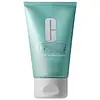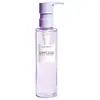What's inside
What's inside
 Key Ingredients
Key Ingredients

 Benefits
Benefits

 Concerns
Concerns

 Ingredients Side-by-side
Ingredients Side-by-side

Glycerin
HumectantSodium Laureth Sulfate
CleansingSodium Chloride
MaskingLauramidopropyl Betaine
CleansingButylene Glycol
HumectantSucrose
HumectantSodium Hyaluronate
HumectantGentiana Lutea Root Extract
Skin ConditioningLaminaria Saccharina Extract
Skin ProtectingCaffeine
Skin ConditioningAcetyl Glucosamine
Skin ConditioningLaureth-2
CleansingPEG-120 Methyl Glucose Dioleate
EmulsifyingSodium Sulfate
Benzophenone-4
UV AbsorberSodium Hydroxide
BufferingEDTA
Disodium EDTA
BHT
AntioxidantPhenoxyethanol
PreservativeCI 42090
Cosmetic ColorantGlycerin, Sodium Laureth Sulfate, Sodium Chloride, Lauramidopropyl Betaine, Butylene Glycol, Sucrose, Sodium Hyaluronate, Gentiana Lutea Root Extract, Laminaria Saccharina Extract, Caffeine, Acetyl Glucosamine, Laureth-2, PEG-120 Methyl Glucose Dioleate, Sodium Sulfate, Benzophenone-4, Sodium Hydroxide, EDTA, Disodium EDTA, BHT, Phenoxyethanol, CI 42090
Water
Skin ConditioningDecyl Glucoside
CleansingCaulerpa Lentillifera Extract
Beta-Glucan
Skin ConditioningSodium Hyaluronate
HumectantVaccinium Angustifolium Fruit
AstringentGlycolic Acid
BufferingLactic Acid
BufferingPhysalis Peruviana Fruit Extract
Skin ConditioningRubus Idaeus Fruit
AstringentArctostaphylos Uva-Ursi Leaf Extract
Skin ConditioningMorus Nigra Fruit Extract
Skin ConditioningVaccinium Myrtillus Fruit Extract
Skin ConditioningScutellaria Baicalensis Root Extract
AstringentPaeonia Suffruticosa Root Extract
Skin ProtectingGlycyrrhiza Glabra Root Extract
BleachingBetaine
HumectantSodium Chloride
MaskingGlycerin
Humectant1,2-Hexanediol
Skin ConditioningButylene Glycol
HumectantParfum
MaskingWater, Decyl Glucoside, Caulerpa Lentillifera Extract, Beta-Glucan, Sodium Hyaluronate, Vaccinium Angustifolium Fruit, Glycolic Acid, Lactic Acid, Physalis Peruviana Fruit Extract, Rubus Idaeus Fruit, Arctostaphylos Uva-Ursi Leaf Extract, Morus Nigra Fruit Extract, Vaccinium Myrtillus Fruit Extract, Scutellaria Baicalensis Root Extract, Paeonia Suffruticosa Root Extract, Glycyrrhiza Glabra Root Extract, Betaine, Sodium Chloride, Glycerin, 1,2-Hexanediol, Butylene Glycol, Parfum
 Reviews
Reviews

Ingredients Explained
These ingredients are found in both products.
Ingredients higher up in an ingredient list are typically present in a larger amount.
Butylene Glycol (or BG) is used within cosmetic products for a few different reasons:
Overall, Butylene Glycol is a safe and well-rounded ingredient that works well with other ingredients.
Though this ingredient works well with most skin types, some people with sensitive skin may experience a reaction such as allergic rashes, closed comedones, or itchiness.
Learn more about Butylene GlycolGlycerin is already naturally found in your skin. It helps moisturize and protect your skin.
A study from 2016 found glycerin to be more effective as a humectant than AHAs and hyaluronic acid.
As a humectant, it helps the skin stay hydrated by pulling moisture to your skin. The low molecular weight of glycerin allows it to pull moisture into the deeper layers of your skin.
Hydrated skin improves your skin barrier; Your skin barrier helps protect against irritants and bacteria.
Glycerin has also been found to have antimicrobial and antiviral properties. Due to these properties, glycerin is often used in wound and burn treatments.
In cosmetics, glycerin is usually derived from plants such as soybean or palm. However, it can also be sourced from animals, such as tallow or animal fat.
This ingredient is organic, colorless, odorless, and non-toxic.
Glycerin is the name for this ingredient in American English. British English uses Glycerol/Glycerine.
Learn more about GlycerinChances are, you eat sodium chloride every day. Sodium Chloride is also known as table salt.
This ingredient has many purposes in skincare: thickener, emulsifier, and exfoliator.
You'll most likely find this ingredient in cleansers where it is used to create a gel-like texture. As an emulsifier, it also prevents ingredients from separating.
There is much debate on whether this ingredient is comedogenic. The short answer - comedogenic ratings don't tell the whole story. Learn more about comegodenic ratings here.
The concensus about this ingredient causing acne seems to be divided. Research is needed to understand if this ingredient does cause acne.
Scrubs may use salt as the primary exfoliating ingredient.
Learn more about Sodium ChlorideSodium Hyaluronate is hyaluronic acid's salt form. It is commonly derived from the sodium salt of hyaluronic acid.
Like hyaluronic acid, it is great at holding water and acts as a humectant. This makes it a great skin hydrating ingredient.
Sodium Hyaluronate is naturally occurring in our bodies and is mostly found in eye fluid and joints.
These are some other common types of Hyaluronic Acid:
Learn more about Sodium Hyaluronate